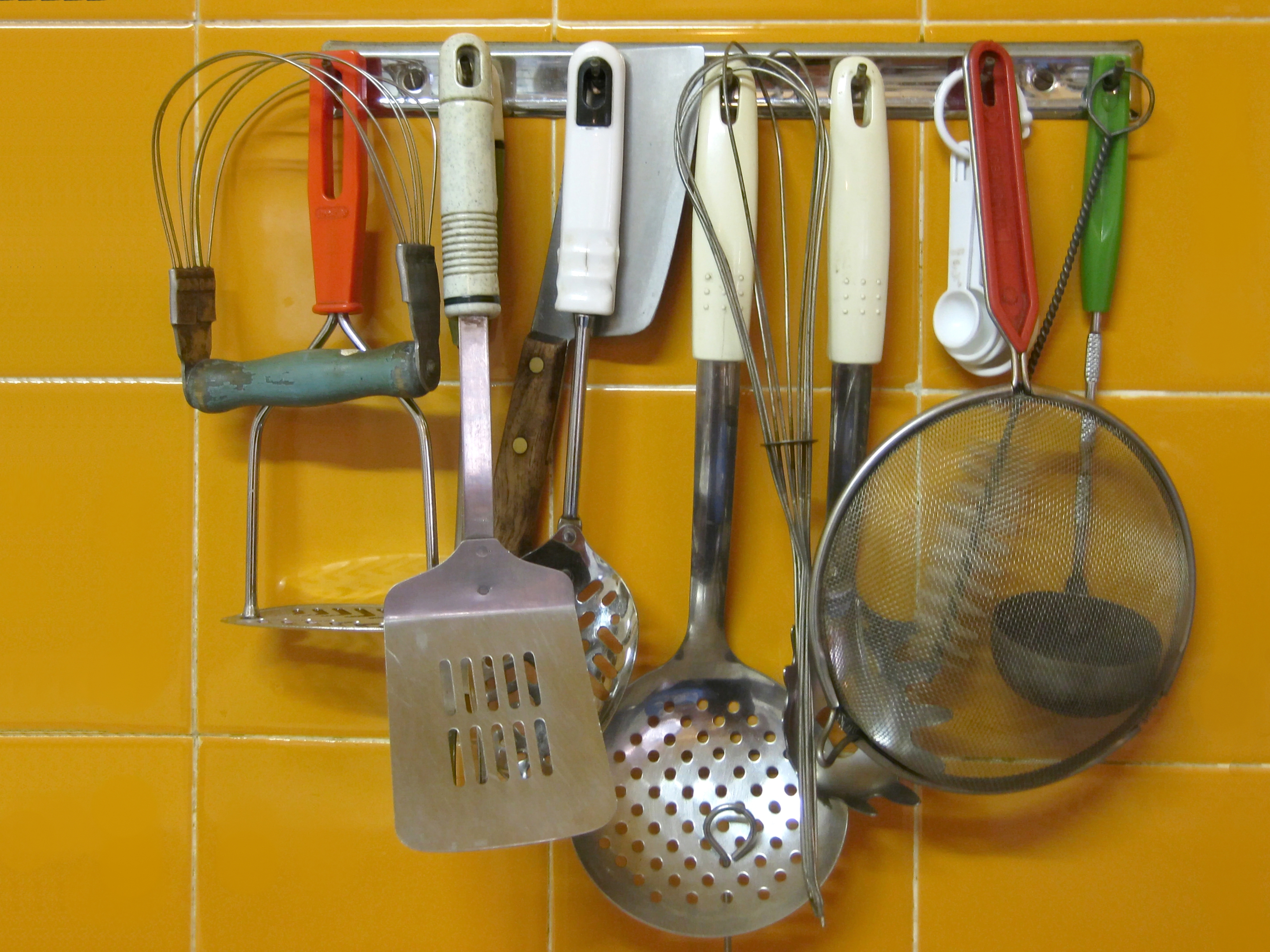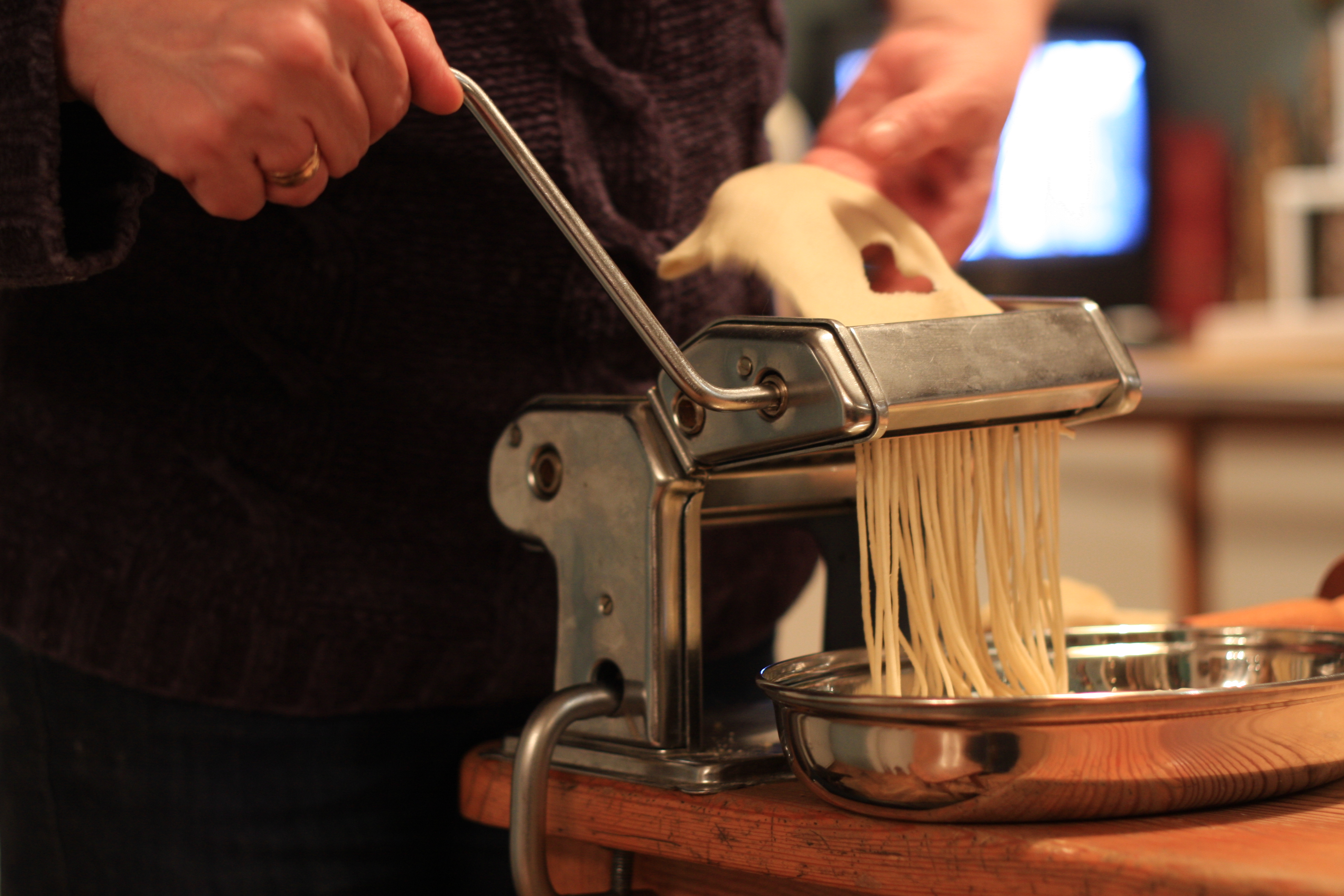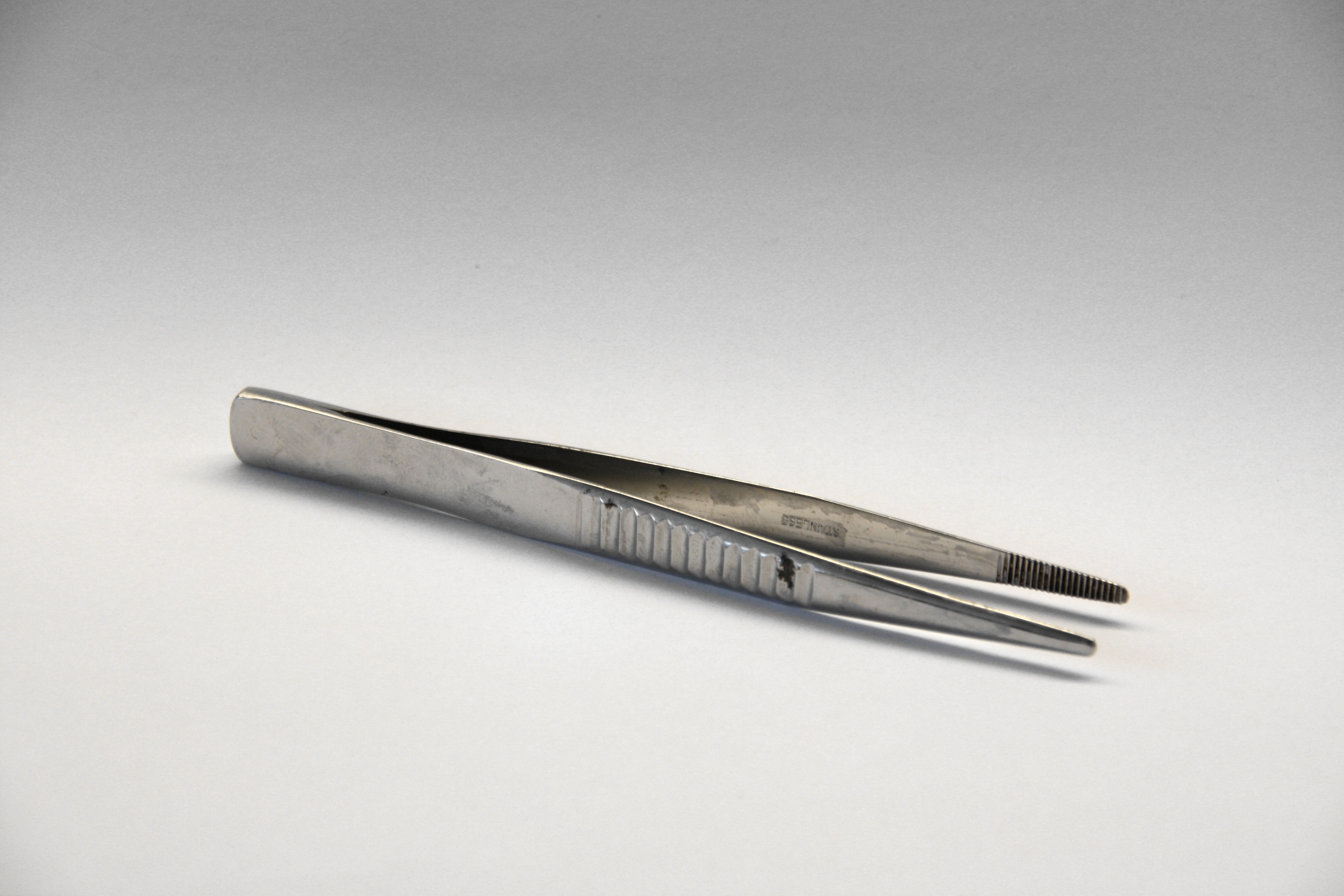|
Tongs
Tongs are a type of tool used to grip and lift objects instead of holding them directly with hands. There are many forms of tongs adapted to their specific use. The first pair of tongs belongs to the Egyptians. Tongs likely started off as basic wooden tongs and then over time progressed to bronze bars as early as 3000BC. Over time they progressed to what we now know as modern-day tongs. An Egyptian wall painting from 1450 BCE shows a crucible supported between two metal bars. The same painting shows someone holding a small object over a fire with a tong-like instrument. Bronze loops capable of handling heavy crucibles also happened to appear at this time. # Tongs that have long arms terminating in small flat circular ends of tongs and are pivoted at a joint close to the handle used to handle delicate objects. Common fire-tongs, used for picking up pieces of coal and placing them on a fire without burning fingers or getting them dirty are of this type. Tongs for grilling, to ... [...More Info...] [...Related Items...] OR: [Wikipedia] [Google] [Baidu] |
Crucible Tongs
Crucible tongs are scissor-like tools, but instead of having two blades, these tools are replaced with two pincers or pieces of metals that concave together, which allow the users to grasp a hot crucibles, flasks, evaporating dishes, or even small beakers. They are made of durable metals, allowing them to endure a very hot temperature when touching with the hot objects. Crucible A laboratory tool that is best fit with crucible tongs is a crucible, a small vessel made from ceramic. Its function is it is used to heat various type of chemicals that are required a very high temperature, usually solid chemicals. This tool is available in various size and form. It can be in a low form or a high form, depends on the types of work. In addition, this vessel can cope with a high temperature up to 565.56 degree Celsius. Feature As a crucible will be very hot when heating it in a furnace or a Bunsen burner, one cannot hold the crucible directly. Therefore, crucible tongs come to play a k ... [...More Info...] [...Related Items...] OR: [Wikipedia] [Google] [Baidu] |
Tweezers
Tweezers are small hand tools used for grasping objects too small to be easily handled with the human fingers. Tweezers are thumb-driven forceps most likely derived from tongs used to grab or hold hot objects since the dawn of recorded history. In a scientific or medical context, they are normally referred to as just "forceps", a name that is used together with other grasping surgical instruments that resemble pliers, pincers and scissors-like clamps. Tweezers make use of two third-class levers connected at one fixed end (the fulcrum point of each lever), with the pincers at the others. When used, they are commonly held with one hand in a pen grip between the thumb and index finger (sometimes also the middle finger), with the top end resting on the first dorsal interosseous muscle at the webspace between the thumb and index finger. Spring tension holds the grasping ends apart until finger pressure is applied. This provides an extended pinch and allows the user to easily gra ... [...More Info...] [...Related Items...] OR: [Wikipedia] [Google] [Baidu] |
List Of Food Preparation Utensils
A kitchen utensil is a hand-held, typically small tool that is designed for food-related functions. Food preparation utensils are a specific type of kitchen utensil, designed for use in the preparation of food. Some utensils are both food preparation utensils and eating utensils; for instance some implements of cutlery – especially knives – can be used for both food preparation in a kitchen and as eating utensils when dining (though most types of knives used in kitchens are unsuitable for use on the dining table). In the Western world, utensil invention accelerated in the 19th and 20th centuries. It was fuelled in part by the emergence of technologies such as the kitchen stove and refrigerator, but also by a desire to save time in the kitchen, in response to the demands of modern lifestyles. [...More Info...] [...Related Items...] OR: [Wikipedia] [Google] [Baidu] |
Fire Iron
A fire iron is any metal instrument for tending a fire. Types There are three types of tools commonly used to tend a small fire, such as an indoor fireplace fire or yule log: the spade, the tongs and the poker itself. These tools make it possible to handle a fire without risk of burns or blisters. A fireplace poker (also known as a fire iron) is a short, rigid rod made of fireproof material used to adjust coal and wood fuel burning in a fireplace, and can be used to stir up a fire. A fireplace poker is usually metallic and has a point at one end for pushing burning materials (or a hook for pulling/raking, or a combination) and a handle at the opposite end, sometimes with an insulated grip. Iron is the most popular metal from which the pokers are wrought. Brass is a more expensive alternative for a home poker set. A slice bar has a flatter tip and can be used to stir up the fire or to clear the grates of ashes. Other fire irons include the fire rake (not to be confused with t ... [...More Info...] [...Related Items...] OR: [Wikipedia] [Google] [Baidu] |
Spaghetti
Spaghetti () is a long, thin, solid, cylindrical pasta.spaghetti Dictionary.com. Dictionary.com Unabridged (v 1.1). Random House, Inc. (accessed: 3 June 2008). It is a of traditional . Like other pasta, spaghetti is made of milled and and sometimes ... [...More Info...] [...Related Items...] OR: [Wikipedia] [Google] [Baidu] |
Forceps
Forceps (plural forceps or considered a plural noun without a singular, often a pair of forceps; the Latin plural ''forcipes'' is no longer recorded in most dictionaries) are a handheld, hinged instrument used for grasping and holding objects. Forceps are used when fingers are too large to grasp small objects or when many objects needed to be held at one time while the hands are used to perform a task. The term "forceps" is used almost exclusively in the fields of biology and medicine. Outside biology and medicine, people usually refer to forceps as tweezers, tongs, pliers, clips or clamps. Mechanically, forceps employ the principle of the lever to grasp and apply pressure. Depending on their function, basic surgical forceps can be categorized into the following groups: # Non-disposable forceps. They should withstand various kinds of physical and chemical effects of body fluids, secretions, cleaning agents, and sterilization methods. # Disposable forceps. They are usually made o ... [...More Info...] [...Related Items...] OR: [Wikipedia] [Google] [Baidu] |
Konnevesi
Konnevesi is a municipality of Finland. It is located in the former province of Western Finland and is part of the Central Finland region. The municipality has a population of () and covers an area of of which is water. Neighbouring municipalities are Hankasalmi, Laukaa, Rautalampi, Vesanto and Äänekoski. The municipality is unilingually Finnish. There are all together exactly 100 lakes in Konnevesi. The biggest lakes are Keitele, Lake Konnevesi and Liesvesi. The population density is . The logging tongs appearing in Konnevesi's coat of arms refer to local forestry. The coat of arms was designed by Gustaf von Numers, and the Konnevesi municipal council approved it in its meetings on April 23, 1964. The Ministry of the Interior approved the coat of arms for use on August 21 of the same year. History Konnevesi was first mentioned in 1554 as ''Konnevessij äremarch''. The name is derived from the lake Konnevesi, which in turn likely got its name from a Sámic word meaning "d ... [...More Info...] [...Related Items...] OR: [Wikipedia] [Google] [Baidu] |
Blacksmith
A blacksmith is a metalsmith who creates objects primarily from wrought iron or steel, but sometimes from #Other metals, other metals, by forging the metal, using tools to hammer, bend, and cut (cf. tinsmith). Blacksmiths produce objects such as gates, grilles, railings, light fixtures, furniture, sculpture, tools, agricultural implements, decorative and religious items, cooking utensils, and weapons. There was an historical distinction between the heavy work of the blacksmith and the more delicate operation of a whitesmith, who usually worked in Goldsmith, gold, Silversmith, silver, pewter, or the finishing steps of fine steel. The place where a blacksmith works is called variously a smithy, a forge or a blacksmith's shop. While there are many people who work with metal such as farriers, wheelwrights, and Armourer, armorers, in former times the blacksmith had a general knowledge of how to make and repair many things, from the most complex of weapons and armor to simple things ... [...More Info...] [...Related Items...] OR: [Wikipedia] [Google] [Baidu] |
Lever
A lever is a simple machine consisting of a beam or rigid rod pivoted at a fixed hinge, or ''fulcrum''. A lever is a rigid body capable of rotating on a point on itself. On the basis of the locations of fulcrum, load and effort, the lever is divided into three types. Also, leverage is mechanical advantage gained in a system. It is one of the six simple machines identified by Renaissance scientists. A lever amplifies an input force to provide a greater output force, which is said to provide leverage. The ratio of the output force to the input force is the mechanical advantage of the lever. As such, the lever is a mechanical advantage device, trading off force against movement. Etymology The word "lever" entered English around 1300 from Old French, in which the word was ''levier''. This sprang from the stem of the verb ''lever'', meaning "to raise". The verb, in turn, goes back to the Latin ''levare'', itself from the adjective ''levis'', meaning "light" (as in "not heavy"). The ... [...More Info...] [...Related Items...] OR: [Wikipedia] [Google] [Baidu] |
Sugar
Sugar is the generic name for sweet-tasting, soluble carbohydrates, many of which are used in food. Simple sugars, also called monosaccharides, include glucose, fructose, and galactose. Compound sugars, also called disaccharides or double sugars, are molecules made of two bonded monosaccharides; common examples are sucrose (glucose + fructose), lactose (glucose + galactose), and maltose (two molecules of glucose). White sugar is a refined form of sucrose. In the body, compound sugars are hydrolysed into simple sugars. Longer chains of monosaccharides (>2) are not regarded as sugars, and are called oligosaccharides or polysaccharides. Starch is a glucose polymer found in plants, the most abundant source of energy in human food. Some other chemical substances, such as glycerol and sugar alcohols, may have a sweet taste, but are not classified as sugar. Sugars are found in the tissues of most plants. Honey and fruits are abundant natural sources of simple sugars. Suc ... [...More Info...] [...Related Items...] OR: [Wikipedia] [Google] [Baidu] |
Pirkei Avot
Pirkei Avot ( he, פִּרְקֵי אָבוֹת; also transliterated as ''Pirqei Avoth'' or ''Pirkei Avos'' or ''Pirke Aboth''), which translates to English as Chapters of the Fathers, is a compilation of the ethics, ethical teachings and Maxim (saying), maxims from Rabbinic Judaism, Rabbinic Jewish tradition. It is part of didactic Jewish Musar literature, ethical literature. Because of its contents, the name is sometimes given as Ethics of the Fathers. Pirkei Avot consists of the Mishnaic Talmud, tractate of ''Avot'', the second-to-last tractate in the order of Nezikin in the Mishnah, plus one additional chapter. Avot is unique in that it is the only tractate of the Mishnah dealing ''solely'' with ethical and moral principles; there is relatively little halakha (laws) in Pirkei Avot. Translation of the title In the title ''Pirkei Avot'', the word "pirkei" is Hebrew for "chapters of". The word ''avot'' means "fathers", and thus ''Pirkei Avot'' is often rendered in English as " ... [...More Info...] [...Related Items...] OR: [Wikipedia] [Google] [Baidu] |









